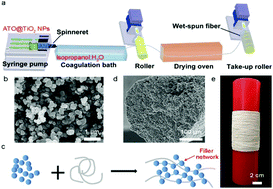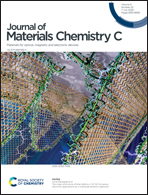Continuous dry–wet spinning of white, stretchable, and conductive fibers of poly(3-hydroxybutyrate-co-4-hydroxybutyrate) and ATO@TiO2 nanoparticles for wearable e-textiles†
Abstract
Stretchable electronic textiles are urgently called for due to the emergence of next generation wearable electronics that can undergo various mechanical deformations that exist almost everywhere in our daily lives. In particular, one-dimensional stretchable fibers with excellent electrical conductivity are a promising building block for the construction of stretchable electronic textiles for wearable electronics. However, the reported conductive fibers for stretchable electronics usually have low stretchability and are dark in color, which greatly limit their applications as display devices and colorful electrical textile fabrics. Herein, we report a simple approach toward the fabrication of continuous white conductive fibers with a high stretchability of over 700%, which could offer superfluous deformation capacity. The fiber was fabricated via a dry–wet spinning process using biomass poly(3-hydroxybutyrate-co-4-hydroxybutyrate) (P3HB4HB) and lab-made electroconductive antimony-doped tin oxide wrapped titanium dioxide nanoparticles (ATO@TiO2 NPs). The system could be mass produced and easily weaved into diverse patterns and shapes. In the resultant composite fiber, the electroconductive ATO@TiO2 NPs are uniformly dispersed in the filler network of P3HB4HB. The fiber revealed impressive reversible mechanical and electrical characteristics within a strain of 420%. Moreover, white stretchable fibers with restorable electroconductive abilities are reported for the first time, thus opening a new opportunity for colorful electrical textile fabrics.



 Please wait while we load your content...
Please wait while we load your content...